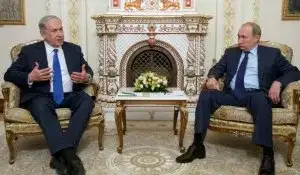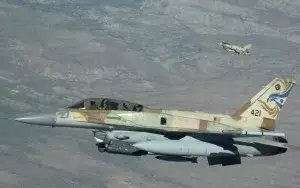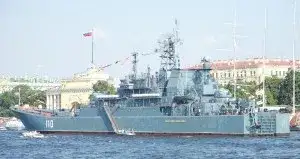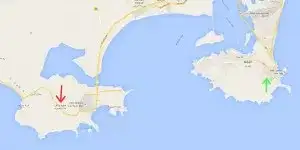Russia and the Middle East
September 24, 2023 by Thomas Wictor
God bless anyone who tries to make peace in the Middle East. I myself don’t have the patience. Too many Middle Easterners are so addicted to fear and discord that they react with hostility to good news. It’s the danger of tradition and campfire tales. The current flurry of Russian activity in Syria is causing trepidation far out of proportion to what can actually happen, but I’ve given up trying to reach people. They prefer to be afraid, so that’s fine. Better them than me.
The only ones who know Russian intentions are Vladimir Putin, the Israelis, and the Arab League. Iran, Syria, and Hezbollah have no idea if Putin plans to help them or if the Russian military buildup in Syria is both window dressing and preparation for the post-mullah, post-Assad era. My guess is that Russia is positioning itself for a radically different future.
On September 21, 2015, Israeli Prime Minister Benjamin Netanyahu flew to Moscow for a three-hour meeting with Vladimir Putin. Netanyahu took three men with him: Lieutenant General Gadi Eizenkot, Major General Herzl Levi, and Yossi Cohen.
Lt-Gen Eizenkot is Chief of Staff of the Israeli Defense Forces, Maj-Gen Levi is Chief of the Military Intelligence Directorate, and Cohen is National Security Adviser to the Prime Minister. By the way, Cohen spent thirty years in the Mossad.
In Moscow the Israeli entourage was joined by Minister of Immigrant Absorption and Minister of Jerusalem Affairs Ze’ev Elkin, who had just come from a visit to the Ukraine. Elkin is said to serve as Netanyahu’s official interpreter, but the reality is that Putin speaks fluent English.
It’s absolutely clear to me that Israel was briefing Putin on the coming war with Iran. That’s why Putin looked like this.
Lt-Gen Eizenkot was chosen as IDF Chief of Staff because of his salient character trait.
Those close to him describe him as an expert on the northern border, a cool and calculated officer, one who will strike hard and fast—but only if he has to.
We’ve reached the “has to” stage. The attack on Iran must be hard and fast, over in a matter of hours.
Putin met with the Israelis in his house. That means he wanted to make absolutely sure that nobody knew what was discussed. In Syria, Russia is expanding its presence at the strategically vital port city of Latakia, at the Istamo weapons depot, and the al-Sanobar military complex. Also, the Russians have sent about 24 ground-attack aircraft, about eight multirole fighter aircraft, helicopter gunships, unmanned aerial vehicles, a handful of main battle tanks, and a handful of infantry fighting vehicles that retain Russian paint jobs and identity numbers.
So far about 200 Russian marines have been deployed, and the bases have accommodations for a grand total of…2000 personnel.
If Putin wanted to save Assad, he would’ve tried to do so by now. The reason he hasn’t tried is that he knows he would’ve failed.
As Russia expands its military presence in Syria, a report was published on Saturday in Russian newspaper Gazeta.ru examining the transfer of weapons, equipment, and manpower from the Russian port city of Novorossiysk to Al Assad base in Syria, and quoting several soldiers who expressed their desire to stay away from the war-torn Middle Eastern country.
The paper interviewed a group of soldiers, mainly non commissioned troops, who refused to deploy to Syria due to their fear of ISIS. One of the soldiers, a lieutenant named Alexei, said, “We don’t want to go Syria, we don’t want to die there.”
Alex Tanzer, an expert on Russian media, explained that President Vladimir Putin passed a law in recent months which banned the publication of names of soldiers killed in action. The law was passed as a result of the public outcry caused by the war in Ukraine. The outcry has been renewed by the soldiers who are being sent to Syria.
In Russia, 20 percent of the defense budget is stolen, and another 20 percent is lost due to inefficiency. The state of training is horrible. These troops are as much a danger to themselves as to the enemy. They’re fighting like Somali militiamen.
They don’t know how to use cover, they never warn each other when they’re about to fire rocket-propelled grenades, and they trip over their own feet. Their marksmanship is nonexistent. These are clowns with weapons. If they’re sent to Syria, they’ll just end up as stars of beheading videos.
This is the third time I’ve posted this. I’m tired of repeating myself. If I know this, all Israelis should know it too.
Israel’s top Air Force officer said Wednesday that Russian S-300 air defense systems, if or when deployed by Iran, would constitute more of “a strategic issue than an operative issue” because it would embolden Tehran to “even more aggressive” behavior.
“It’s a huge challenge,” Maj. Gen. Amir Eshel, Israel Air Force commander conceded, when asked about a May 26 announcement — following meetings in Moscow between Russian and Iran officials — that the systems would be delivered to Iran at an unspecified time.
“But it’s more a strategic issue… because whoever has the S-300 feels protected. He can allow himself to do things even more aggressively, because he thinks he’s defended,” Eshel told Defense News.
He added, “But operatively speaking, every challenge presents an opportunity.”
“I tell you now, and obviously this is based on all kinds of assessments we’ve done … that the enemy cannot stop our Air Force.
“They can complicate our activities, but it will be pinpoint complications here and there. But to stop this offensive machine that we have cannot be done.”
The Israelis are pathologically conservative in their estimates. If the Israel Air Force commander says that no Russian missile poses a threat to his aircraft, you can take that to the bank.
All the circumstantial evidence points to Russia doing nothing to save Assad or Iran. The Russians don’t have the capability, and besides, they’re helping the Arab League fight Iran’s proxies.
Russia and Egypt are holding their first ever joint naval exercise, Russia’s defence ministry said on Saturday, strengthening the ties between two states which were once Cold War allies.
The eight-day drills off the Mediterranean Egyptian port of Alexandria, beginning today, will include supply and communication at sea, search operations, all forms of defence at sea and firing exercises.
“The goal of the exercise is to strengthen and develop military co-operation between Egypt’s navy and Russia’s navy in the interests of security and stability on the sea,” the ministry said.
Russia is contributing the missile cruiser Moskva, corvette Samum, landing ship Alexander Shabalin, tanker Ivan Bubnov and a tugboat, while Egypt is contributing the frigates Taba and Damiyat, the tanker Shatalin, two patrol boats and two F-16 fighters.
The Alexander Shabalin is a large landing ship (LLS).
It’s used for one thing only: amphibious landings. Sometime in early July, the United Arab Emirates landed hundreds of main battle tanks, infantry fighting vehicles, light armored vehicles, mine resistant ambush protected vehicles, and self-propelled artillery pieces in Little Aden (red arrow).
Though I’m certain that the Russians carried out the landings, I have no proof. However, the Egyptian navy provided fire support. The June 6, 2015, first-ever joint Egyptian-Russian naval exercise was a rehearsal for an amphibious landing. That can’t be argued. All the assets used in that eight-day training session were offensive in nature, including the Alexander Shabalin. At the very least, Russia helped Egypt practice the landings.
Saudi Arabia says that Russia is ready to give up on Iran. The Saudis have more to offer Putin than do the mullahs. Almost every army in the Middle East prefers Russian weapons. The Arab Marshall Plan that the Gulf Cooperation Council is talking about financing will mean a massive windfall for Russia.
It may seem to you that Russia is giving Iran and Syria help, but a total of 2000 extremely reluctant, poorly trained troops will change nothing. All the Arab and African units I’ve identified in Saudi Arabia and Yemen are massively skilled, specialized assault formations. Any one of those units could completely destroy the Russians. Beginning on May 2, 2015, a total of fifteen UAE Presidential Guardsmen fought over 40,000 Houthis, Saleh loyalists, and Revolutionary Committee militiamen in Aden. The Guardsmen used antitank guided missiles (ATGMs) as their main weapons. They engaged the enemy for nine weeks and suffered no casualties.
In this video, Saudi Apache gunship crews fighting in Yemen are speaking English to “Control,” the authority commanding the mission.
“Control” answers in accented English. This is clearly for the benefit of people who don’t speak Arabic but are involved in the operation.
I’m excited. From now on my blog posts are intended for me and those who accept that the world is changing for the better. I’m done being cross examined by people who have no factual knowledge. You’re the teeming masses. The hoi polloi. Be afraid of everything, and continue with your tribal traditions.
But leave me out of it, okay?
Update
Short answer: Of course not.
This article viewed 763 times.




